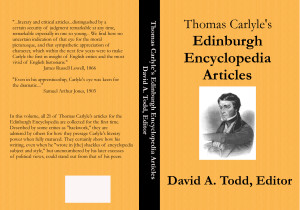
Of the many books, essays, and articles written by 19th Century British author Thomas Carlyle, perhaps none is more iconic than Sartor Resartus: The Life and Opinions of Herr Teufelsdröckh. Written in 1830 and 1831, serialized in 1833-34, published in the USA in 1836 and in Great Britain in 1938, Carlyle’s life changed from landed poverty to the beginning of success by the time it came out in London. Throughout Carlyle’s life it grew in popularity. The year he died it sold seventy-thousand copies in an inexpensive edition. For the life of me I don’t know why.

I’m slowly working my way through Carlyle’s works, in the chronological order they were written. About five weeks ago I came up to Sartor. Having read little bits of it and knowing it was a hard book to understand, I waited a little while before tackling it. Finally I did, reading an e-book version. At times I read with good concentration; at other times I read in distracted conditions. Generally when I did the latter, I went back and re-read the section again in a quieter time. Did I understand it better? Alas, no. The more I read, the more I determined to stick with it and understand it, the more I would zone out after five or ten minutes.
I have no idea what the purpose of the book is/was. The fictitious professor, Diogenes Teufelsdröckh, is said to have written a (fictitious) book on the philosophy of clothes. That much I knew before I read it. But in the book, I found precious little about clothes. D.T.’s life history is given. His lost love is described. Endless words describe…endless nonsense. Or so to me it seems like nonsense.
I purposely didn’t read commentary on Sartor before reading it, allowing me to get it for myself. But I didn’t “get it.” I found the flow of ideas almost unintelligible. I think Emerson said it well in his first letter to Carlyle in 1834: “I have now received four numbers of the Sartor Resartus…has literature any parallel to the oddity of the vehicle chosen to convey this treasure? I delight in the contents; the form, which my defective apprehension for a joke makes me not appreciate, I leave to your merry discretion. And yet did ever wise and philanthropic author use so defying a diction?” If Emerson had problems with it I guess I’m in good company. To give you an idea of the difficulty of reading Sartor, go back and read the second sentence in this review. I purposely made that complex. Yet, it would be one of the simpler sentences in Sartor.
Carlyle’s early works I understood well. The further into his career, he found his “diction” and “style” and became less understandable. His pivotal work as to style was his essay “Novalis”. I had to read and reread that to understand what Carlyle was saying. I read it all thrice and parts of it four times and felt that I came to a basic understanding of it. The essays between that and Sartor were a mix of difficulty and clear writing. But Sartor made “Novalis” seem like a Little Golden Book.
I can’t give Sartor any more than 2-stars. Perhaps, if I read it again as planned, and come to a better understanding, I’ll come back and edit this review. If I had a paper copy of Sartor, I would keep it as part of my larger Carlyle collection, but not because I think it’s good. I’ll re-read it again someday, probably in the near future. Perhaps I’ll even understand it.